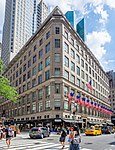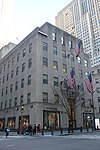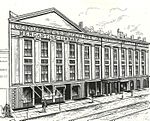Charles Scribner's Sons Building

The Charles Scribner's Sons Building, also known as 597 Fifth Avenue, is a commercial structure in the Midtown Manhattan neighborhood of New York City, on Fifth Avenue between 48th and 49th Streets. Designed by Ernest Flagg in a Beaux Arts style, it was built from 1912 to 1913 for the Scribner's Bookstore. The Fifth Avenue facade contains a glass-and-iron storefront on its lowest two stories with black and gold decoration. On the third through ninth stories, the facade is subdivided into five limestone bays, while at the tenth story is a mansard roof. Among the facade's details are vertical piers with four medallions containing busts of printers: Benjamin Franklin, William Caxton, Johann Gutenberg, and Aldus Manutius. The interior of the first two stories contains a retail space that initially served as a location of the Scribner's Bookstore. The upper stories contain offices, including some space that was initially used by the Scribner's publishing company. The Charles Scribner's Sons Building was constructed to supersede a previous bookstore at 155 Fifth Avenue. The building was owned by Scribner's until 1984, when it was sold to the Cohen family, which subsequently sold it to the Benetton Group. After the bookstore in the lowest two stories closed in 1989, the building has housed numerous retail shops. A&A Investment Co. bought 597 Fifth Avenue in 2006 and it was sold to Thor Equities in 2011. The New York City Landmarks Preservation Commission designated 597 Fifth Avenue as an official landmark in 1982 and designated the ground-floor interior as a landmark in 1989.
Excerpt from the Wikipedia article Charles Scribner's Sons Building (License: CC BY-SA 3.0, Authors, Images).Charles Scribner's Sons Building
5th Avenue, New York Manhattan
Geographical coordinates (GPS) Address Nearby Places Show on map
Geographical coordinates (GPS)
| Latitude | Longitude |
|---|---|
| N 40.7575 ° | E -73.977777777778 ° |
Address
5th Avenue 601
10017 New York, Manhattan
New York, United States
Open on Google Maps







